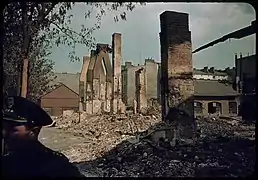Praga
Praga is a district of Warsaw, Poland. It is on the east bank of the river Vistula. First mentioned in 1432, until 1791 it formed a separate town with its own city charter.

.jpg.webp)



History
The historical Praga was a small settlement located at the eastern bank of the Vistula river, directly opposite the towns of Old Warsaw and Mariensztat, both being parts of Warsaw now. First mentioned in 1432, it derived its name from the Polish verb prażyć, meaning to burn or to roast, as it occupied a forested area that was burnt out to make place for the village. Separated from Warsaw by a wide river, it developed independently of the nearby city, and on February 10, 1648 king Władysław IV of Poland granted Praga with a city charter. However, as it was mostly a suburb and most buildings were wooden, the town was repeatedly destroyed by fires, floods and foreign armies. Currently the only surviving historical monument from that epoch is the Church of Our Lady of Loreto.
Although there were numerous attempts to build a permanent bridge across the river, none succeeded and Praga remained a separate entity well into the 18th century. Communication between the capital and Praga was maintained by privately run ferries and, in the winter, over the ice. Finally, in 1791, during the reign of Stanisław August Poniatowski, Praga was attached to Warsaw as a borough.
The Battle of Praga, or Battle of Warsaw of 1794, was a Russian assault during the Kościuszko Uprising in 1794. It was followed by a massacre in which over 20,000 inhabitants of the Praga district lost their lives.
Unlike the western parts of Warsaw, Praga remained relatively untouched during World War II and in the postwar period of reconstruction, the capital was home to many ministries and public facilities. A Soviet War Memorial was located here.[1]
Because of the traditional separate status of Praga, there are two Catholic dioceses in Warsaw: Archdiocese of Warsaw[2] with St. John's Cathedral and Diocese of Warsaw-Praga[3] with St. Florian's Cathedral.
The district experienced a revival following the end of Communism in 1989, as young artists moved into many of the former factory buildings, drawing crowds in search of something different from the Old Town. The increasing popularity of the area helped to change it into one of Poland's and Europe's creative hubs as it has been described as one of the "trendiest neighbourhood across Europe".[4]
In 2011 the local Monument to Brotherhood in Arms was taken down; in 2015 this decision was made permanent.
Administrative division
Currently Praga is administratively divided into:
- Praga-Północ (Praga North)
- Praga-Południe (Praga South)
Praga-Południe and Praga-Północ include neighborhoods of:
- Saska Kępa
- Grochów
- Szmulowizna
- Gocław
- Kamionek
In the wider sense, all areas of Warsaw located on the right bank of Vistula are also known under the collective term of Praga. Besides historical Praga, they include:
Tourist attractions
References
- http://www.inyourpocket.com/poland/warsaw/sightseeing/praga/Soviet-War-Memorial_18425%5B%5D
- "Archdiocese of Warszawa {Warsaw}". Catholic Hierarchy. Retrieved 2010-08-07.
- "Diocese of Warszawa-Praga". Catholic Hierarchy. Retrieved 2010-08-07.
- "The Trendiest Neighbourhoods Across Europe". Retrieved 2018-08-06.
External links
![]() Media related to Praga (Warsaw) at Wikimedia Commons
Media related to Praga (Warsaw) at Wikimedia Commons
.jpg.webp)
